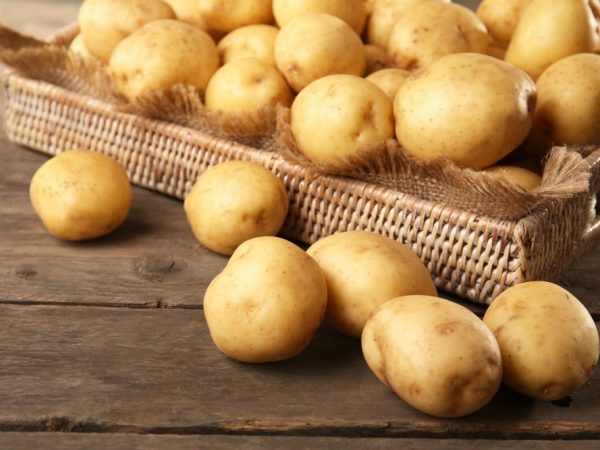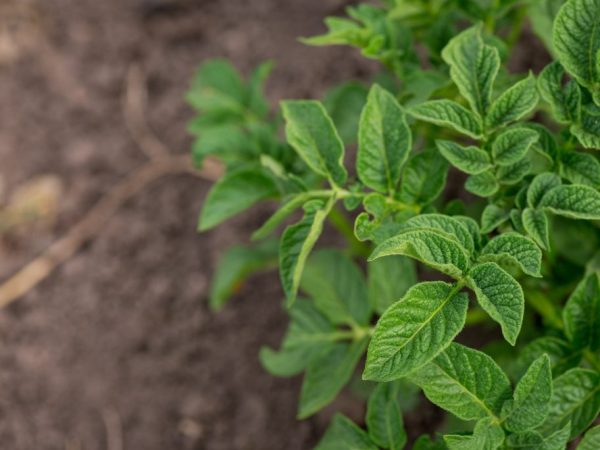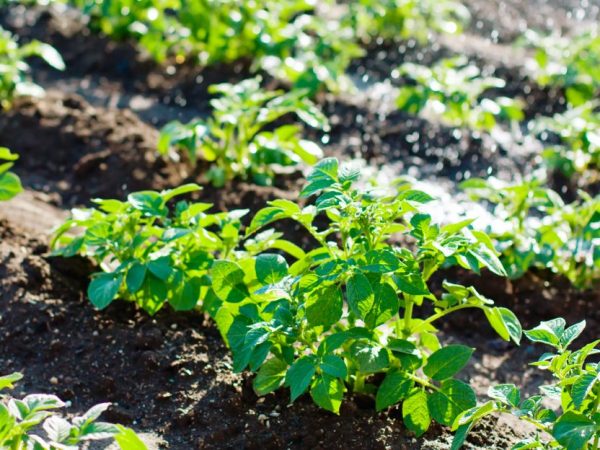Characteristics of Natasha potatoes
Natasha potatoes are promising and highly productive. Although he was bred relatively recently, this did not prevent him from winning the sympathy of a large number of gardeners and summer residents. Recently, it has become more and more popular, and it is well deserved. The description of the culture allows one to be convinced of its merits and visible advantages over other varieties.

Characteristics of Natasha potatoes
Features of the variety
Potato variety Natasha is early, its ripening period is only 70-80 days. Belongs to table species and has excellent taste.
Description of the bush
- small, semi-upright, intermediate type;
- the leaves are large, their edges are wavy, the color depends on the concentration of nitrogen in the soil and varies from light green to dark;
- corolla is characterized by complete or partial absence of anthocyanin color inside.
Description of fruits
- oval shape;
- small eye-points;
- weight - 100-135 g;
- the peel is light yellow;
- the pulp is dark yellow.
Potatoes contain about 11 to 13.5% starch. The culture belongs to German breeders, they bred it at the beginning of the 21st century.
Advantages and disadvantages
The advantages of this nightshade are obvious. Natasha potatoes, the characteristic speaks for itself:
- high yield - from 130 to 190 c / ha;
- good taste;
- easily tolerates heat and drought;
- has good keeping quality, is not afraid of mechanical damage;
- gives high productivity on all types of soil, even not very fertile;
- resistant to many painful conditions (cyst nematode, potato cancer, tuber rot, rhizoctonia, Y-virus).
This variety does not have any disadvantages. With proper care and cultivation, it produces a good harvest and
Planting potatoes
The potatoes are planted in accordance with the principles of planting early crops. 1.5 months before the planned planting, the planting material is taken out of the storage facility to a warm room for acclimatization. Sprout medium, healthy and intact Natasha seed potatoes, with adequate lighting. After germination, seed potatoes of the Natasha variety are treated with the Hercules growth stimulator and the Prestige pest preparation.
Soil preparation

Fertilized soil will increase crop yields
The site for planting the culture is prepared in the fall. The soil is dug deeply, organic and mineral fertilizers are applied.
Organic matter should be applied in this way:
- in clay soil - 10 kg of humus (peat);
- in a sandy area - 10 kg of rotted manure, peat and clay;
- in peat - a bucket of clay, sand and rotted manure.
Humus can be replaced with bird droppings: dilute 200 g of droppings in a bucket of water and water the area.
In addition, 20 g of superphosphate, a glass of ash, no more than 10 g of potash fertilizers are applied to 1 m² of the plot. Sour soil is quenched with lime (up to 200 grams of lime is taken per 1 m²).
In the spring, the soil is dug up again, weeds are selected and leveled. During planting, up to 5 tablespoons of wood ash and about 500 g of humus are introduced into the hole.
The holes are made at a distance of 30-35 cm from each other, the rows - at a distance of 65-70 cm. The planted area is leveled with harrows or rakes.
Potato care
Before sprouting, it is necessary to remove weeds from the potato field, harrow and loosen the soil with a rake so that a crust does not appear. After emergence, the soil is carefully loosened with hoes. The formation of rows is a signal to hilling the site. It is not recommended to huddle the plant in hot regions, as the tubers can be roasted underground.
Watering
Potato variety Natasha, like all other nightshades, is thermophilic. He for a relatively short period and tops, and tubers. The roots of the plant are short, up to 30 cm, so it takes moisture and nutrients from the top layer of the soil.
Watering should be carried out at the optimal time and you need to know exactly how much water a plant requires at a given time. Lack of moisture, as well as its excess, negatively affect the productivity of nightshades.
Some gardeners believe that the crop does not require constant watering, and this does not prevent them from having a good harvest. Watering the potatoes is, of course, necessary, just some areas are located in low-lying areas, and the plant has enough moisture. Heavy and dense soils also have high humidity, especially when it rains frequently. If there is water in the aisles, watering is not necessary. On a sandy bed, watering will have to be done throughout the growing season.

Potatoes need to be watered as needed
Watering is done in two ways:
- Manual watering is carried out using a watering can, bucket or hose, which the gardener himself brings to each crop. This method is effective, since all plants are provided with the necessary moisture. It is ideal for small potato beds. In doing so, you can save water and water only the plants, and not the entire land around them. About 3 liters of water is poured under each plant, it is better to do this in portions: first pour in 1 liter, after a while, when the water is absorbed, pour in more and more. It is easier to do this with a hose, but so that the soil at the roots does not erode, a sprayer should be put on its end. Watering the top layer of the earth in one row, go to the second, and then return to the first.
- Sprinkler irrigation or drip irrigation allows moisture to be delivered to the soil surface or directly to the roots. It facilitates the work of gardeners and summer residents and will be an ideal solution for those who, due to poor health or age, cannot tolerate heaviness. Irrigation devices are installed above ground or distributed by nets underground. The above-ground version is not suitable for use during the flowering of the crop, since it becomes possible to wash off the pollen, which has a bad effect on the growing season and yield. The underground method delivers water directly to the roots, while a crust does not form on the ground and the earth does not compact. This makes it easier to care for the bushes and saves time.
The disadvantage of mechanical irrigation is the high cost of such equipment and additions to it. Not every gardener and summer resident can buy it for himself.
Fertilizer
The culture must be fed with organic matter and mineral fertilizers. Organic fertilizers are fertilized as follows: rotted manure is applied under each plant, at a distance of 5-7 cm from the bush (2 handfuls) and scattered between the rows.
After that, the hoe digs the fertilizer into the ground. If the site is small, use slurry, diluting it with water in a ratio of 1: 5. Pour the top dressing carefully so that it does not fall on the leaves of the culture, under each bush - up to 1.5 liters. It is best to fertilize potatoes after watering or in rainy weather.
Fertilizing crops in marginal areas is carried out 3 times during the growing season:
- The first feeding is carried out during the period of emergence of the first shoots. In this area, seedlings are weak, pale green in color. A tablespoon of dry bird droppings is diluted in a bucket of water. At least 500 ml is poured under each plant. If there are no organic matter and mineral fertilizers, use the so-called "green" solution. For its preparation, nettles are collected and finely chopped. 10 kg of nettle mass is poured into a barrel, poured with water and left to ferment for several days. You can add a bucket of ripe manure to the barrel. A liter of nutrient solution is poured under each culture.
- The second feeding is carried out during the budding period. Several tablespoons of wood ash are diluted in 10 liters of water. The resulting solution is watered over the plants.
- The third time the plants are fertilized during flowering to speed up and stimulate tuber formation. In this case, chicken manure is ideal: 200 g of fertilizer is dissolved in a bucket of water. No more than 0.5 l of solution is poured under each plant.
Feeding three times a day allows you to get a good harvest of potatoes.
Pest control
This potato variety rarely suffers from painful conditions, but constant monitoring of the condition of the tops never hurts. If symptoms of at least one of them are found, the bushes are treated with fungicides or insecticides.
In the fight against Colorado beetles in small areas, it is recommended to use biological methods. Pests and their larvae are collected and burned.
Conclusion
The characteristic of Natasha potatoes confirms its promise and prospects. It is highly valued by foreign and domestic gardeners due to its high yield, immunity to diseases, excellent taste, good marketability and ability to be stored for a long time.

